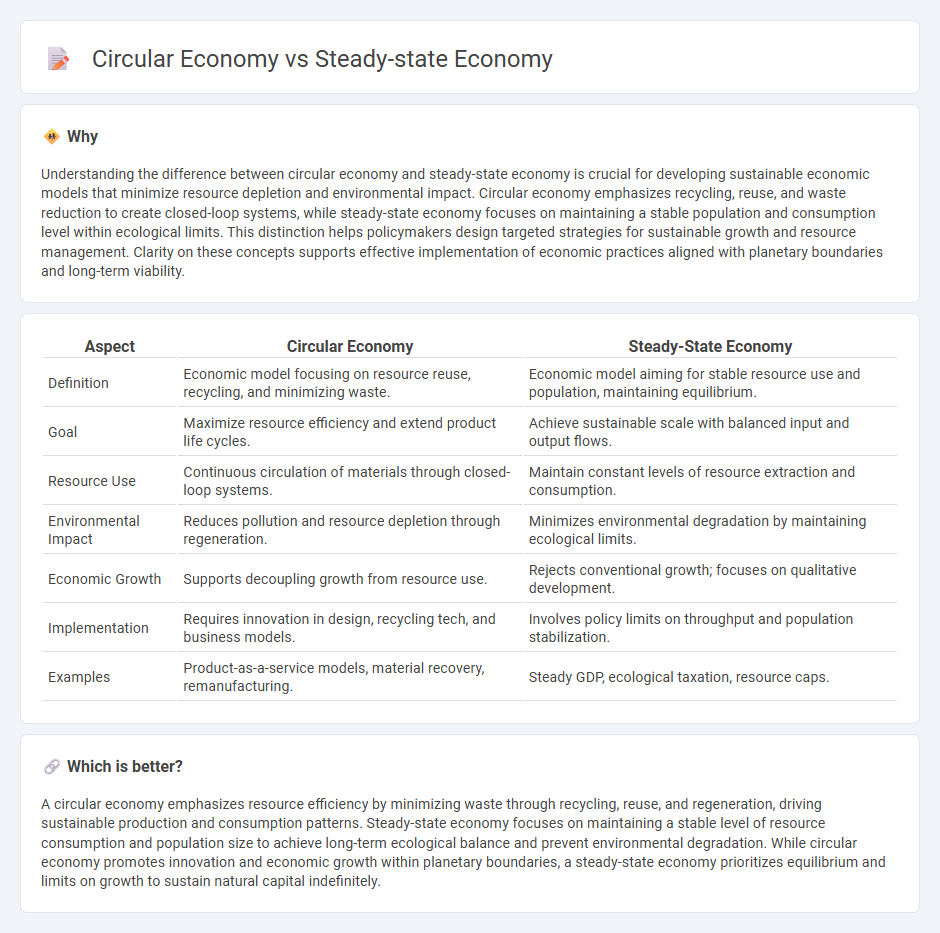
Circular economy focuses on designing products for reuse, recycling, and reducing waste to create a closed-loop system that minimizes resource input and environmental impact. Steady-state economy emphasizes maintaining a stable level of resource consumption and economic activity to achieve long-term ecological balance and sustainability. Explore the differences between these economic models to understand their roles in shaping future sustainability strategies.
Why it is important
Understanding the difference between circular economy and steady-state economy is crucial for developing sustainable economic models that minimize resource depletion and environmental impact. Circular economy emphasizes recycling, reuse, and waste reduction to create closed-loop systems, while steady-state economy focuses on maintaining a stable population and consumption level within ecological limits. This distinction helps policymakers design targeted strategies for sustainable growth and resource management. Clarity on these concepts supports effective implementation of economic practices aligned with planetary boundaries and long-term viability.
Comparison Table
| Aspect | Circular Economy | Steady-State Economy |
|---|---|---|
| Definition | Economic model focusing on resource reuse, recycling, and minimizing waste. | Economic model aiming for stable resource use and population, maintaining equilibrium. |
| Goal | Maximize resource efficiency and extend product life cycles. | Achieve sustainable scale with balanced input and output flows. |
| Resource Use | Continuous circulation of materials through closed-loop systems. | Maintain constant levels of resource extraction and consumption. |
| Environmental Impact | Reduces pollution and resource depletion through regeneration. | Minimizes environmental degradation by maintaining ecological limits. |
| Economic Growth | Supports decoupling growth from resource use. | Rejects conventional growth; focuses on qualitative development. |
| Implementation | Requires innovation in design, recycling tech, and business models. | Involves policy limits on throughput and population stabilization. |
| Examples | Product-as-a-service models, material recovery, remanufacturing. | Steady GDP, ecological taxation, resource caps. |
Which is better?
A circular economy emphasizes resource efficiency by minimizing waste through recycling, reuse, and regeneration, driving sustainable production and consumption patterns. Steady-state economy focuses on maintaining a stable level of resource consumption and population size to achieve long-term ecological balance and prevent environmental degradation. While circular economy promotes innovation and economic growth within planetary boundaries, a steady-state economy prioritizes equilibrium and limits on growth to sustain natural capital indefinitely.
Connection
Circular economy and steady-state economy share a focus on sustainability by minimizing resource consumption and waste generation. Both models prioritize maintaining ecological balance through regenerative design and limiting economic throughput to Earth's carrying capacity. Implementing circular economy principles supports the steady-state goal of a stable, equitable economy that operates within environmental limits.
Key Terms
Sustainable resource use
A steady-state economy emphasizes maintaining a stable level of resource consumption and waste output to achieve long-term ecological balance, while a circular economy prioritizes closing material loops through recycling, reuse, and regenerative practices. Both models aim for sustainable resource use but differ in approach; the steady-state model limits growth to preserve natural capital, whereas the circular model innovates within existing economic structures to minimize resource extraction. Explore the nuances and strategies of these economic frameworks for sustainable resource management to deepen your understanding.
Economic growth limits
A steady-state economy emphasizes maintaining a stable level of resource consumption and population to achieve long-term ecological balance, explicitly recognizing the limits of continuous economic growth. The circular economy focuses on minimizing waste and maximizing resource efficiency through recycling and reuse but often operates within the context of ongoing economic expansion. Explore how these models address the challenges of sustainable growth and resource constraints.
Waste minimization
A steady-state economy emphasizes maintaining a stable level of resource consumption and waste output through sustainable practices, aiming to balance economic activity with ecological limits. The circular economy prioritizes waste minimization by designing products for reuse, repair, and recycling, effectively creating closed-loop systems that reduce material input and waste generation. Explore how integrating steady-state and circular economies can optimize waste reduction strategies for long-term environmental sustainability.
Source and External Links
The Steady State Economy: Limits to Economic Growth? - A steady-state economy is one in which demand, supply, production, and population size remain stable and sustainable, aiming for economic activity that supports the population without exceeding resource limits, thus promoting social cohesion and efficient resource use.
Balancing Act: How the Steady-State Economy Seeks Equilibrium - The steady-state economy prioritizes ecological balance over continuous growth by stabilizing population and consumption levels, focusing on wellbeing and sustainability instead of GDP growth, and protecting natural ecosystems for future generations.
Steady-state economy - Wikipedia - Herman Daly proposes politically establishing steady-state institutions that limit income and wealth inequality, stabilize population through reproduction licenses, and cap resource use via depletion quotas to prevent further economic growth and maintain ecological balance.
 dowidth.com
dowidth.com